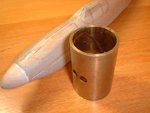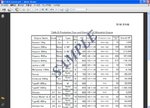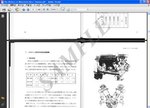Navigation
Install the app
How to install the app on iOS
Follow along with the video below to see how to install our site as a web app on your home screen.
Note: This feature may not be available in some browsers.
More options
You are using an out of date browser. It may not display this or other websites correctly.
You should upgrade or use an alternative browser.
You should upgrade or use an alternative browser.
Data Base: Japanese Aircraft Engines (1 Viewer)
- Thread starter Shinpachi
- Start date
Ad: This forum contains affiliate links to products on Amazon and eBay. More information in Terms and rules
More options
Who Replied?I have obtained the book "The History of Mitsubishi Aero-Engines" at last.
Does anyone help me with translation for English?
The lists of about twenty pages would interest the researchers.
I must admit myself that I have no time for it anymore at all.
If someone might be interested, please help. Thanks.
Grate thanks to you. dear Shinpachi.

That is definitely that I needed. I had much less production info regarding Mitsubishi engines then Nakajima ones, here it is.

Please scan other tables with figures and pictures that are in this book, I bag you

The most important data is on the page 183
Can somebody explain strage dates in raws 3 4?
I can not get what data is in the table on p.182. Seems its regarding 1945 year and expences for 3 Kaseis 25/26 Ha-43?
And on pp. 152-153 there are less important tables what engines and modifications were installed on serial 1) or designing 2) aircrafts.
Last edited:
- Thread starter
- #43
Title of the page 183 is "Table 4 - Production Year and Grand Total of HPs of Mitsubishi Engines".
I find so many translation errors on it, not only the engine type but the production years....
Page 182 shows the order details Mitsubishi accepted in 1945.
Page 152-153 shows .... Specs of NE-330 and the best 5 engines during the Pacific War in order of production quantity.
Image attached.
Please give me some more time to scan and edit.
Thanks for your enthusiasm.

I find so many translation errors on it, not only the engine type but the production years....
Page 182 shows the order details Mitsubishi accepted in 1945.
Page 152-153 shows .... Specs of NE-330 and the best 5 engines during the Pacific War in order of production quantity.
Image attached.
Please give me some more time to scan and edit.
Thanks for your enthusiasm.
Last edited:
Shinpachi-sama,
We had SNOW on Friday in Yokohama. Something must've been very wrong up there. I am sorry but the only thing I can contribute to this thread is as below. The metal part alongside the fuselage of a 1/32 Mustang is (said to be) the piston pin metal of the Navy Hi-Shiki engine (a license build Hispano-Suiza).
We had SNOW on Friday in Yokohama. Something must've been very wrong up there. I am sorry but the only thing I can contribute to this thread is as below. The metal part alongside the fuselage of a 1/32 Mustang is (said to be) the piston pin metal of the Navy Hi-Shiki engine (a license build Hispano-Suiza).
Attachments
- Thread starter
- #45
Konbanwa, ppopsie-san.
What a fantastic treasure you have!
I have never known the parts of Hi-shiki engines are still available.
Your wooden solid Mustang also interests me, though
Thanks!
* Konbanwa = Good evening
*Hi-shiki = Type Hi (Hi for Hispano)
What a fantastic treasure you have!
I have never known the parts of Hi-shiki engines are still available.
Your wooden solid Mustang also interests me, though
Thanks!
* Konbanwa = Good evening
*Hi-shiki = Type Hi (Hi for Hispano)
- Thread starter
- #46
- Thread starter
- #48
- Thread starter
- #49
This is my translation of page 183.
I have converted it to a pdf file attached that contains text information.
I wish it any help for you, Aurum
Thanks.
Hi Shinpachi
Please note that Type 91 850 hp is NOT Mitsubishi but Nakajima Ha-5 engine produced by license. Also Kasei 20ies serie is NOT A14 but A10 project.
Con not understand what is the sense of summarized total power of each model of engines i.e. useless figures.
But if are there any figures of work/time expenditures or costs of any of engine models?
Does anybody translate table on 182 page? What figures are there?
- Thread starter
- #51
- Thread starter
- #52
I have scanned all pages anyway.
Thanks.
Thanks.
Attachments
- Thread starter
- #53
Faulty!
I have applied OCR - Optical Character Recognition on the scanned image before the machine translation.
OCR result was very good but.....
Sample of page 1 in below
本書によせて
三菱名古屋航空機のスタートは内燃機(エンジン)から始まりました。機体は
終戦時までに85機種の試作,開発機が造られました。零戦,百式司偵,一式陸攻,
飛龍など優れた飛行機を製造してきましたが,これらの名機も搭載された発動機
との相性があって,それぞれの性能を発揮しておりました。
一般に飛行機として記憶に残るのは機体,外形であり,その飛行機がどんな発
動機を積んでいようがあまり意識されません。本書は発動機を主体に書かれたも
のであり,あの名機を名機たらしめたのは,それぞれの発動機によるところ大で
あることを理解していただく為のもので,どんなに素晴らしい飛行機でも発動機
が力不足であったり,信頼性が無かったりでは十分な成果を挙げられません。
三菱の発動機は昭和初期までは確かなるものもなく,海軍をして(三菱の発動
機よ,何処え行くなどと揶揄されました。これがやがて「機体は三菱,エンジ
ンは中島」という風潮になりましたが,この後,この汚名返上を成し遂げたのが
深尾名発所長でした。それは,まず核になる三菱オリジナルのエンジンを造れと
いうことで[金星]が生まれ,以降それに改良を加えて「火星」「瑞星」という
スターエンジンが生まれました。
やがて三菱のエンジンは信頼性が高いと言う定評が得られ,攻撃機,爆撃機な
ど力強く,また長時間の飛行を必要とする機種に採用されました。かの世界一周
飛行を遂げた「ニッポン号」の金星発動機は,日本に帰りつくまで,ほとんど部
品を交換する必要がなかったと言われたほどでした。
やがて三菱の発動機は三菱機のみのものではなく,日本の,さらに世界の飛行
機に搭載して貰えるものにすべきであるというビジョンを掲げ,各発動機の改良,
派生型が開発されていきました。これらの機種は,多岐に亘るため素人では把握
しにくいのですが,本書ではその点にも配慮され,容易に理解しやすくまとめら
れております。発動機は機体と違って,外観は皆同じような形で,妙味がなく,
Celebrating the publication
================
The start of the Mitsubishi Nagoya aircraft started from the machine of [mo] on the inside (engine). As for the airframe, making for trial purposes and the development machine of 85 models were made by the end of the war. There was compatibility with the engine equipped with these great machines, and each performance was demonstrated though an excellent airplane like 0 games and 100 expression [tsukasado**], complete set [okaseme], and wyverns, etc. had been manufactured. In general, it is not considered so much though it is an airframe, externals that remain in the memory as an airplane, and the airplane is piling up what kind of engine. The engine is power shortage, and there is no reliability and an enough result is not achieved by a very wonderful airplane in the one for great machine [tarashimetanoha] and each engine to understand it is large as for [taride] the one that the engine was written in the subject this book the achievement of that great machine either. There was not the certain one until ..engine of Mitsubishi.. the beginning of the Showa era either, and what conduct oneself food did naval forces and ..(.. ..engine of Mitsubishi.. was ridiculed when taking it. It was a Fukao great departure head to have accomplished this destigmatization after this though this became a trend of the age "In the airframe, Mitsubishi and the engine were Nakashima" before long. It appeared in making the engine of original Mitsubishi that first became a nucleus Venus, added the improvement to it later, and the star engine "Mars" and "[**hoshi]" appeared. As for the engine of Mitsubishi, the reputation said that it was dependable was obtained, and the attack aircraft and the bomber, etc. were powerful and adopted for the model that needed the flight for a long time before long. It was said that the Venus engine of "Nippon title" that accomplished the flight once in the [kano] world can hardly replace a part until returning to Japan and attaching. The vision that the engine of Mitsubishi had to make it to not the one of a Mitsubishi machine alone but what of Japan the airplane in the world was able to install it in addition hung, and the improvement and the derived type of each engine were developed before long. The respect is considered, and it is easy to understand easily and is brought together in this book though the amateur doesn't understand easily because these models extend to many topics. The engine is different from the airframe, and all externals are in similar shape the charm, and.....

I have applied OCR - Optical Character Recognition on the scanned image before the machine translation.
OCR result was very good but.....
Sample of page 1 in below
本書によせて
三菱名古屋航空機のスタートは内燃機(エンジン)から始まりました。機体は
終戦時までに85機種の試作,開発機が造られました。零戦,百式司偵,一式陸攻,
飛龍など優れた飛行機を製造してきましたが,これらの名機も搭載された発動機
との相性があって,それぞれの性能を発揮しておりました。
一般に飛行機として記憶に残るのは機体,外形であり,その飛行機がどんな発
動機を積んでいようがあまり意識されません。本書は発動機を主体に書かれたも
のであり,あの名機を名機たらしめたのは,それぞれの発動機によるところ大で
あることを理解していただく為のもので,どんなに素晴らしい飛行機でも発動機
が力不足であったり,信頼性が無かったりでは十分な成果を挙げられません。
三菱の発動機は昭和初期までは確かなるものもなく,海軍をして(三菱の発動
機よ,何処え行くなどと揶揄されました。これがやがて「機体は三菱,エンジ
ンは中島」という風潮になりましたが,この後,この汚名返上を成し遂げたのが
深尾名発所長でした。それは,まず核になる三菱オリジナルのエンジンを造れと
いうことで[金星]が生まれ,以降それに改良を加えて「火星」「瑞星」という
スターエンジンが生まれました。
やがて三菱のエンジンは信頼性が高いと言う定評が得られ,攻撃機,爆撃機な
ど力強く,また長時間の飛行を必要とする機種に採用されました。かの世界一周
飛行を遂げた「ニッポン号」の金星発動機は,日本に帰りつくまで,ほとんど部
品を交換する必要がなかったと言われたほどでした。
やがて三菱の発動機は三菱機のみのものではなく,日本の,さらに世界の飛行
機に搭載して貰えるものにすべきであるというビジョンを掲げ,各発動機の改良,
派生型が開発されていきました。これらの機種は,多岐に亘るため素人では把握
しにくいのですが,本書ではその点にも配慮され,容易に理解しやすくまとめら
れております。発動機は機体と違って,外観は皆同じような形で,妙味がなく,
Celebrating the publication
================
The start of the Mitsubishi Nagoya aircraft started from the machine of [mo] on the inside (engine). As for the airframe, making for trial purposes and the development machine of 85 models were made by the end of the war. There was compatibility with the engine equipped with these great machines, and each performance was demonstrated though an excellent airplane like 0 games and 100 expression [tsukasado**], complete set [okaseme], and wyverns, etc. had been manufactured. In general, it is not considered so much though it is an airframe, externals that remain in the memory as an airplane, and the airplane is piling up what kind of engine. The engine is power shortage, and there is no reliability and an enough result is not achieved by a very wonderful airplane in the one for great machine [tarashimetanoha] and each engine to understand it is large as for [taride] the one that the engine was written in the subject this book the achievement of that great machine either. There was not the certain one until ..engine of Mitsubishi.. the beginning of the Showa era either, and what conduct oneself food did naval forces and ..(.. ..engine of Mitsubishi.. was ridiculed when taking it. It was a Fukao great departure head to have accomplished this destigmatization after this though this became a trend of the age "In the airframe, Mitsubishi and the engine were Nakashima" before long. It appeared in making the engine of original Mitsubishi that first became a nucleus Venus, added the improvement to it later, and the star engine "Mars" and "[**hoshi]" appeared. As for the engine of Mitsubishi, the reputation said that it was dependable was obtained, and the attack aircraft and the bomber, etc. were powerful and adopted for the model that needed the flight for a long time before long. It was said that the Venus engine of "Nippon title" that accomplished the flight once in the [kano] world can hardly replace a part until returning to Japan and attaching. The vision that the engine of Mitsubishi had to make it to not the one of a Mitsubishi machine alone but what of Japan the airplane in the world was able to install it in addition hung, and the improvement and the derived type of each engine were developed before long. The respect is considered, and it is easy to understand easily and is brought together in this book though the amateur doesn't understand easily because these models extend to many topics. The engine is different from the airframe, and all externals are in similar shape the charm, and.....
- Thread starter
- #55
Shortround6
Lieutenant General
Thank you very much for your work

- Thread starter
- #57
- Thread starter
- #59
Yes, I may still need somebody's help for translation as my time is utterly in shortage as I must work, eat and sleep....though I have my own plan to translate them by myself after all...
Here is my little advice.
The pdf resolution is large enough to be read by OCR.
Japanese OCR free software is here.
I think this 'SmartOCRlite' was orginally developed by English in overseas, so, if you have English version, you may be able to use it with Japanese text from the Japanese version.
Sorry but thanks.
Here is my little advice.
The pdf resolution is large enough to be read by OCR.
Japanese OCR free software is here.
I think this 'SmartOCRlite' was orginally developed by English in overseas, so, if you have English version, you may be able to use it with Japanese text from the Japanese version.
Sorry but thanks.
unlucky the installation program it's in japanese so i can't install it (and over my pc don't show japanese characters). so i start a research for a ocr that can read japanese but it's not japanese, i'll tell to all eventually good results
Users who are viewing this thread
Total: 2 (members: 0, guests: 2)



